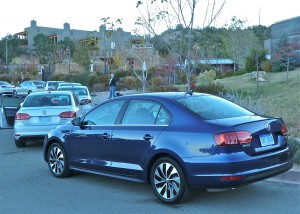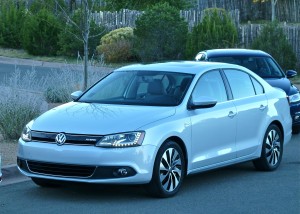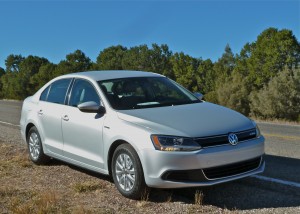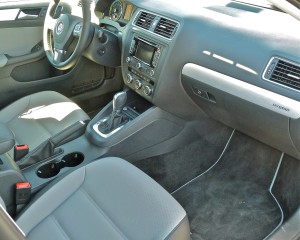New Jetta combines turbo pep with hybrid mpg
By John Gilbert
SANTA FE, N.M. — Driving down from the 8,000-foot altitude of Santa Fe, we descended toward a curve so I flicked the new Jetta’s shift lever and downshifted to fourth gear, and when the curves tightened up, I dropped it down to third, both to slow a bit and to be in the power band for accelerating out of the curve.
Coaxing a good-handling sports sedan to trace those curves can be exhilarating fun, especially when deploying a direct-sequential gearbox to instantly respond. This was not a GLI, although its handling and performance created a fair impersonation of that hottest of Jetta models.
This was, in fact, the Jetta Turbo Hybrid, all new for 2013. What makes it unique is that by using a smaller-displacement 1.4-liter 4-cylinder engine, with direct-injection and turbocharging, the power of a larger engine suddenly is joined by the economy of a smaller one. And then it adds a lithium-ion battery pack as Volkswagen’s first-ever hybrid sedan. But the emphasis retains the fun-to-drive aspect of a true sporty car, even while getting hybrid-class fuel economy.
Without question, I enjoyed pushing the Jetta harder through the curves than my more conservative co-driver. In our brief driving, I found spots to go from 70-75 miles per hour and otherwise drove at 50-65, where speed limits required it. My feeling was that the power and stability was up there close to high-performance stature but without the uncompromising harshness sometimes found with sports-car rigidity. On the economy side, I finished my fairly hard segment and then clicked the computer until I saw the number: I had averaged 47.5 miles per gallon.
That was extremely impressive, although an hour later, my co-driver got 50.8, on mostly sustained highway driving. Our conclusion was that the Jetta Turbo Hybrid is either an extremely economical performance car, or an amazingly high-performing economy car.
“If you want to help this planet, building a green car is not enough,” said Rainier Michel. “It must also be appealing to look at, and fun to drive.”

Jetta is aimed at the crowded compact class, but now is loaded with five different engine variations.
Michel is the very German vice president of VW marketing strategy, and he drives a high-performing Golf R in his private life, meaning it’s impossible to extract his urge for fun-to-drive motoring from everyday driving. We should all be thankful for that.
It’s important to connect all three words — Jetta, Turbo and Hybrid — because Volkswagen had never built a hybrid sedan before, and nobody has ever hooked up a turbocharged engine to a hybrid battery pack. VW has done both, to assure that the Jetta Turbo Hybrid would meet and exceed both hybrid and high-performance aspirations.
In the past decade, Japan’s Toyota and Honda led the way in developing combined gas-electric hybrid drive systems, in which the traditional gas engine is complemented by electric power, with its battery pack recharged by the gas engine. German companies rivaled the 40-50-mpg fuel economy figures of hybrids with their turbo-diesels, so focused on that technoogy.
The U.S. was left behind in both categories, until Ford started producing its own very good full-hybrid systems in the Escape and Fusion. General Motors tried only mild hybrids in its trucks and some cars, using electric power to run accessories, but not helping move the vehicles and thus fall far short of true hybrid fuel economy. Then GM came up with the Volt, which is not a hybrid but runs on pure electric power for 30-40 miles and then converts to a separate gas engine for subsequent driving until reaching a plug-in source.
Ford is bringing out a wave of new hybrids and electric vehicles in the next year, and Toyota and Honda have hiked their technology, while GM announced it will devote future planning to plug-in electrics, rather than hybrids. That seems curious, considering the high-efficiency of contemporary hybrids, which has now lured Volkswagen to enter the field. VW had previously built a hybrid Touareg SUV, using a 3-liter V6 and a nickel-metal-hydride battery pack. It is pretty good, but Volkswagen certainly isn’t giving up on its diesel technology, although the U.S. market is adopting hybrids and still seems in the dark about diesels.
“Sixty percent of Europeans buy diesel cars,” Michel said. “In the U.S., the take-rate on diesels is 1 percent. Our Jetta TDI [turbo-diesel] take-rate is from 21-24 percent, and we’re looking at getting that up to 30 percent. Everyone who drives our TDI models is impressed, but for those customers who aren’t buying diesels but still want eco-friendly cars, hybrids offer a good alternative.”
Driving a hybrid traditionally is satisfying in a new way, if you forego sporty driving to attain lofty fuel economy figures, you can appreciate dueling with yourself to improve miles per gallon. Or it can be symbolically satisfying if you have a more expensive hybrid with a larger gasoline engine, which limits the improvement of fuel economy but allows you to join ecological elitists.
Neither of those extremes seems to interest Volkswagen, which has had time to evaluate and assess the performance, or lack thereof, among competitors’ hybrids before creating a combination of ecology, economy and a dose of fun. When Volkswagen summoned waves of automotive journalists to drive its first true hybrid car in the 8,000-foot mountain altitude of Santa Fe, we might have wondered, “What are we doing here?”
Not because we weren’t happy to be in Santa Fe, a beautiful and scenic location rising up above the New Mexico desert. But when an auto manufacturer introduces a hybrid, it generally chooses an urban setting, because the gas engine yields operation to the electric motor, leading to the best fuel economy, in low-speed urban areas. Volkswagen, however, wanted to prove its Jetta Turbo Hybrid’s potency.
Volkswagen has several high-tech, small-displacement engines in Europe. The 1.4 “EA111” used in German small cars was completely refined to “EA211” designation, with decreased bore and longer stroke to improve torque and better handle turbocharging. By itself, the little 4 develops 150 horsepower and 170 foot-pounds of torque.
A slick, lithium-ion battery pack, made by Sanyo, with recyclable components including nickel, manganese and cobalt, complements the gas engine by adding the equivalent of 27 horsepower and 114 foot-pounds of torque to the 1.4 gas engine. The combination puts out 170 horsepower, and 184 foot-pounds of torque, which peaks at only 1,000 RPMs, barely above idle speed.
Similar in concept to Honda’s sophisticated hybrid system, the electric module is fitted between the transverse-mounted engine and the transmission — which is an ultra-slick 7-speed dry clutch direct-sequential-gearbox unit. The ability to manually shift the shift lever puts the fun quotient beyond the scope of the continuously-variable transmissions most competitors use with their hybrids. That fulfills another of the objectives of VW, and Ranier Michel.
“We’ve shown 0-60 times of 8.6 seconds,” said Michel. “We decided to use the best gas engine technology, such as cylinder deactivation, so it would be good at highway speed, and the torque-converter keeps the clutch at the right place, so it’s fun to drive.”
As in the wet-clutch DSGs used by other VWs, this one has two clutches inside the transmission, one engaging first, third, fifth, and seventh, while the other engages second-fourth-sixth, making shifting silky smooth as the computer and driver’s input induce upshifts and downshifts.
To make sure customers know VW is serious about performance fun, VW prepared a Jetta Turbo Hybrid for the Bonneville Salt Flats in Utah for some high-speed runs. Competing in the H/PS category, for cars with under 1.5 liters displacement and forced-induction (turbocharging), the Jetta set a record with a top speed of 187.607 mph, and a complete run averaging 186.13 mph.
That was just for demonstration purposes, Michel explained with a wink. The production Jetta Turbo Hybrid is electronically governed for a maximum 125 mph in the U.S., but its potential made VW officials confident to show it wouldn’t run out of breath when a gang of auto journalists drove them at 8,000 feet, the sort of altitude that normally drains the life out of small engines and hybrids.
The fun quotient was proven quickly, but VW intends the car to be among the leaders in real-world fuel efficiency, and our driving indicated a surprisingly potent combination of the two.
“If you start up at slower speed, it starts as an EV [electric vehicle], and at normal acceleration the gas engine disengages and you continue as an EV up to 37 miles per hour, for over one mile. If you select ‘E‘ mode, the zero-emission EV range is extended to 44 mph, and allows for more aggressive gas-pedal application.
“When you step on the gas hard enough, the clutch closes, starting the gas engine, which powers the car and produces more power than is needed to charge the battery pack. Kick it down harder, or go to the ‘S‘ mode, and the electric motor joins the gas engine for maximum power.”
That gives Jetta drivers the option of using “active” boost, with the gas engine boosted by the electric motor, or “passive” boost, in which the electric motor disengages from helping the gas engine but still runs all the accessories.
The Jetta, which fits between the more-compact Golf and the midsize Passat, was redesigned two years ago, tailored to be less expensive, and it met with some criticism because it was quite plain, inside and out. I didn’t agree with the criticism, because the uncluttered lines of most German cars have an enduring appeal that doesn’t seem to age as they get older. Besides, it is simplified to move into direct competion with the likes of the Honda Civic, Toyota Corolla, Mazda3, and all-new models of Ford Focus, Hyundai Elantra, and Chevrolet Cruz, among others. In that segment, prices start in the $17,000 range, and the Jetta offers a base 2.0-liter 4-cylinder at that inexpensive level.
Moving upscale, a 2.5-liter 5-cylinder powers the Jetta SE and SEL models, with the more powerful 2.0 Turbo 4-cylinder in the impressive GLI. Over and above those, the Jetta TDI offers the high-mpg 2.0-liter turbo-diesel. That array gives the Jetta an advantage over other compacts, none of which offers a diesel. Now the Jetta Turbo Hybrid, giving Jetta a fifth engine plan, which can be ordered in the base model at $25,000, although most of them are aimed at the more upscale Jetta models.
Some of those other compacts do offer sporty versions, but even from our brief first drives in high altitude, the Jetta Turbo Hybrid gives the Jetta something special. Driving it hard or easy, it is difficult to say which is more impressive, its quick agility or its outstanding fuel economy. A fair dose of both is what competitors and customers alike might say is an unfair advantage.
.
Comments
Tell me what you're thinking...
and oh, if you want a pic to show with your comment, go get a gravatar!






 John Gilbert is a lifetime Minnesotan and career journalist, specializing in cars and sports during and since spending 30 years at the Minneapolis Tribune, now the Star Tribune. More recently, he has continued translating the high-tech world of autos and sharing his passionate insights as a freelance writer/photographer/broadcaster. A member of the prestigious North American Car and Truck of the Year jury since 1993. John can be heard Monday-Friday from 9-11am on 610 KDAL(www.kdal610.com) on the "John Gilbert Show," and writes a column in the Duluth Reader.
John Gilbert is a lifetime Minnesotan and career journalist, specializing in cars and sports during and since spending 30 years at the Minneapolis Tribune, now the Star Tribune. More recently, he has continued translating the high-tech world of autos and sharing his passionate insights as a freelance writer/photographer/broadcaster. A member of the prestigious North American Car and Truck of the Year jury since 1993. John can be heard Monday-Friday from 9-11am on 610 KDAL(www.kdal610.com) on the "John Gilbert Show," and writes a column in the Duluth Reader.